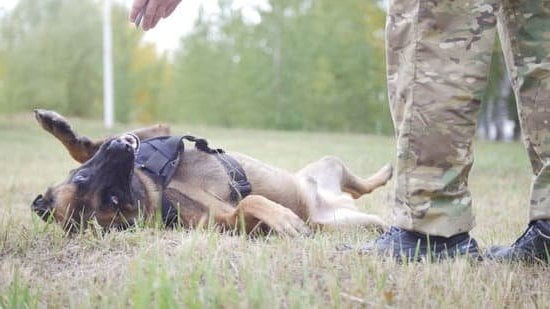How to train your dog to sense seizures is a vital skill for individuals with epilepsy or other seizure disorders. Seizures can be unpredictable and potentially dangerous, making it essential for those who suffer from them to have assistance in the event of an episode.
In this article, we will explore the process of training a dog to detect and respond to seizures, from understanding what seizures are and how they affect individuals, to choosing the right breed, building a strong bond, and implementing specific training techniques.
It’s important to first understand what exactly seizures are and the impact they have on those who experience them. By gaining insight into the nature of seizures, their different types, and how they manifest in individuals, we can better comprehend why having a seizure detection dog can be life-changing for someone with a seizure disorder.
We will also delve into the role of assistance dogs in aiding individuals with medical conditions, focusing on how these specially trained animals can provide invaluable support and safety for those living with epilepsy or other seizure disorders. Additionally, this section will explore which breeds possess the qualities needed for effective seizure detection and assistance, as well as how to form a strong bond between owner and dog-crucial for successful training.
The Role of Assistance Dogs
Assistance dogs play a crucial role in the lives of individuals with various medical conditions, including seizures. These specially trained dogs can provide invaluable support and assistance to their owners, helping them to live more independently and safely. From detecting the onset of a seizure to providing comfort and assistance during an episode, these remarkable animals can make a significant difference in the lives of their human counterparts.
Benefits of Assistance Dogs
Assistance dogs are trained to perform specific tasks that can help individuals with medical conditions lead more fulfilling lives. For individuals with seizures, these dogs can provide a sense of security and peace of mind by alerting them or others when a seizure is about to occur. In addition to seizure detection, these dogs can also offer physical support during and after a seizure, as well as emotional comfort for their owners.
Types of Assistance Dogs
There are different types of assistance dogs that are trained to assist individuals with specific medical conditions. Seizure response dogs are specifically trained to respond to seizures by providing assistance during or after an episode. On the other hand, seizure alert dogs are trained to detect subtle changes in their owner’s behavior or physiology before a seizure occurs, allowing them to provide an early warning signal.
Overall, assistance dogs have the potential to significantly improve the quality of life for individuals with seizures by providing constant companionship, support, and even lifesaving intervention. Finding the right dog and investing time in training and building a strong bond is essential for successfully utilizing the incredible abilities of these special animals.
Choosing the Right Dog
When it comes to training a dog to detect seizures, choosing the right breed and individual dog is crucial. While many breeds can be trained for seizure detection and assistance, some are more predisposed to excel in this role than others.
Breeds such as Golden Retrievers, Labrador Retrievers, and Standard Poodles are known for their intelligence, trainability, and gentle temperament, making them popular choices for seizure assistance dogs. These breeds also have a strong sense of smell, which is essential for detecting changes in body chemistry that may occur during a seizure.
In addition to breed characteristics, specific qualities such as attentiveness, empathy, and calmness are important when selecting a dog for seizure detection and assistance. These qualities can greatly influence a dog’s ability to recognize subtle changes in their owner’s behavior or physical state, as well as their response in providing comfort or seeking help during a seizure event.
When choosing a dog for this specialized role, it’s important to consider the individual personality and behavior of the dog. Not all dogs within a particular breed will exhibit the same traits or have the temperament needed for seizure detection and assistance. Therefore, potential owners should work with reputable breeders or rescue organizations with experience in training assistance dogs to ensure they find the best match for their needs.
| Breed | Qualities |
|---|---|
| Golden Retriever | Intelligent, trainable, gentle temperament |
| Labrador Retriever | Intelligent, obedient, strong sense of smell |
| Standard Poodle | Trainable; hypoallergenic coat; good sense of smell |
Building a Bond
Building a strong bond and trust between an owner and their dog is crucial when training the dog to sense seizures. Dogs are highly intuitive animals and can pick up on subtle changes in their owner’s behavior and body chemistry. To train a dog to effectively sense seizures, it is important to establish a close relationship with the dog through bonding activities.
Spend Quality Time Together
Spending quality time with your dog is essential for building a strong bond. Engage in activities that both you and your dog enjoy, such as playing, going for walks, or simply spending quiet time together. This will help to create a connection based on trust and companionship.
Positive Reinforcement
Using positive reinforcement techniques during training sessions can strengthen the bond between you and your dog. Rewarding good behavior with treats, praise, or playtime helps to create a positive association with training and builds trust between you and your canine companion.
Communication and Understanding
Establishing clear communication with your dog is key to building a strong relationship. Learn to understand your dog’s body language, vocalizations, and cues. This will help you develop a deeper understanding of your dog’s needs and behaviors, ultimately leading to a stronger bond based on mutual respect and trust.
By focusing on building a strong bond with your dog, you can create a solid foundation for successful seizure detection training. The trust and connection established between you and your canine partner will be essential as you move forward with advanced training techniques for seizure detection.
Basic Training
Training a dog to sense seizures requires a foundational understanding of basic obedience and communication. A well-trained dog is more likely to be successful in learning specialized skills for seizure detection and response. Basic training includes teaching the dog commands such as sit, stay, come, and heel. These commands form the basis for effective communication between the owner and their assistance dog.
Consistency is critical in basic training. Dogs thrive on routine and repetition, so regular practice of commands in different environments will help reinforce their learning. It is also essential to use positive reinforcement techniques such as treats, praise, and play to motivate the dog during training sessions. Through positive reinforcement, the dog will learn that following commands leads to rewards, making them more eager to respond to instructions.
A crucial aspect of basic training is socialization. Exposing the dog to various people, animals, sounds, and environments from an early age helps them become well-adjusted and confident in different situations. This socialization lays the groundwork for the advanced training necessary for seizure detection work. By focusing on building a strong foundation through basic obedience training and communication with the dog, owners can prepare their canine companions for more specialized seizure detection training.
| Basic Training | Teaching Basic Obedience |
|---|---|
| Commands: Sit, Stay, Come, Heel | Treats: Positive reinforcement |
| Socialization: Exposure to various stimuli | Repetition: Consistent practice of commands |
Advanced Training
Training a dog to sense seizures and respond appropriately requires advanced techniques and specialized training. It is important to understand that not all dogs are capable of becoming successful seizure detection dogs, so choosing the right breed and individual qualities is crucial. Here are some steps to help you introduce specific seizure detection and response techniques:
- Targeting specific behaviors: Begin by identifying behaviors or actions that your dog can exhibit when detecting a seizure. This could include pawing at the owner, barking, whining, or staying close to the person experiencing the seizure.
- Training with scent samples: Introduce your dog to scent samples taken from a person experiencing a seizure. By associating this specific scent with a positive outcome such as treats or playtime, the dog can learn to recognize and respond to the scent when an actual seizure occurs.
- Practice scenarios: Create controlled scenarios where someone simulates having a seizure while the dog is present. This will allow you to observe any natural responses from your dog and reinforce these behaviors through positive reinforcement.
Advanced training for seizure detection and response involves patience, consistency, and ongoing practice. It is important to seek guidance from professional trainers who specialize in training assistance dogs for individuals with medical conditions.
With dedication and perseverance, your dog can become an invaluable companion in helping monitor and respond to seizures. Remember that not all dogs may be suitable for this type of training, so it’s important to assess your dog’s temperament, behavior, and capabilities before embarking on advanced training techniques.
Understanding Your Dog’s Signals
As a dog owner training your dog to sense seizures, it is crucial to understand the subtle cues that dogs may exhibit when they sense a seizure coming on. These cues can vary from one dog to another, so it’s important to pay close attention to your own dog’s behavior in order to recognize these signals. Here are some common signs that your dog may exhibit when sensing a seizure:
- Restlessness or agitation
- Pawing or whining at their owner
- Nuzzling or licking the individual who is about to have a seizure
- Intense focus and staring at the person experiencing the seizure
- Barking or howling for attention
It’s important to note that not all dogs will exhibit all of these signs, and some dogs may display different behaviors altogether. It is essential for dog owners to observe and learn their specific dog’s unique indicators that signal the onset of a seizure.
In addition, understanding and recognizing these cues is just as crucial as teaching your dog how to detect seizures. By being attentive and aware of your dog’s behaviors, you can work together effectively in order to provide assistance when needed. With patience and diligence, you can develop a strong partnership with your canine companion for successful seizure detection.
Practice and Perseverance
In conclusion, training a dog to sense seizures can be a highly rewarding and life-changing endeavor for both the individual with medical conditions and their canine companion. It is important to understand the nature of seizures and the potential for dogs to assist individuals in detecting and responding to them. The selection of the right breed and qualities in a dog, as well as building a strong bond between owner and dog, are crucial first steps in this process.
Once the foundation is set, basic obedience and communication training can lay the groundwork for more advanced seizure detection techniques. Consistent practice, reinforcement, and perseverance are key to ensuring the success of the dog in accurately sensing seizures. By understanding subtle cues that dogs may exhibit when a seizure is impending, individuals can better prepare themselves and their loved ones for timely intervention.
Ultimately, ongoing training is vital to maintaining the dog’s ability to detect seizures. It is an ongoing process that requires dedication, but the potential benefits for individuals with medical conditions are immeasurable. With patience and commitment, both owner and dog can work together to improve quality of life through successful seizure detection.
Frequently Asked Questions
Can You Train a Dog to Detect Seizures?
Yes, it is possible to train a dog to detect seizures. Some dogs have a natural ability to sense changes in their owner’s body odor, behavior, or movements that occur just before a seizure. Trainers can then work with these dogs to further develop and refine this skill through positive reinforcement and training techniques.
How Do You Qualify for a Seizure Alert Dog?
Qualifying for a seizure alert dog typically involves being diagnosed with epilepsy or another condition that causes frequent seizures. Potential owners may need to provide medical documentation of their condition and demonstrate that they can care for and handle a service dog. Additionally, they may need to work with an accredited organization that specializes in training seizure alert dogs.
Is My Dog Aware During a Seizure?
It’s often believed that some dogs are aware when their owner is experiencing a seizure. They may stay close by, whine, or exhibit other unusual behaviors during the event.
However, this awareness can vary depending on the individual dog and the specific circumstances of the seizure. Dogs may not always be able to provide any assistance during a seizure, but their presence and support can still be comforting for their owner.

Welcome to the blog! I am a professional dog trainer and have been working with dogs for many years. In this blog, I will be discussing various topics related to dog training, including tips, tricks, and advice. I hope you find this information helpful and informative. Thanks for reading!





